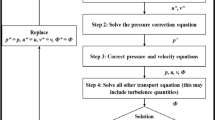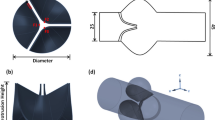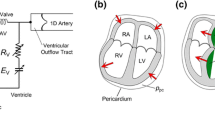Abstract
Mouse models of atherosclerosis have become effective resources to study atherogenesis, including the relationship between hemodynamics and lesion development. Computational methods aid the prediction of the in vivo hemodynamic environment in the mouse vasculature, but careful selection of inflow and outflow boundary conditions (BCs) is warranted to promote model accuracy. Herein, we investigated the impact of animal-specific versus reduced/idealized flow boundary conditions on predicted blood flow patterns in the mouse thoracic aorta. Blood velocities were measured in the aortic root, arch branch vessel, and descending aorta in ApoE−/− mice using phase-contrast MRI. Computational geometries were derived from micro-CT imaging and combinations of high-fidelity or reduced/idealized MR-derived BCs were applied to predict the bulk flow field and hemodynamic metrics (e.g., wall shear stress, WSS; cross-flow index, CFI). Results demonstrate that pressure-free outlet BCs significantly overestimate outlet flow rates as compared to measured values. When compared to models that incorporate 3-component inlet velocity data [\(\mathop{v}\limits^{\rightharpoonup} \left( {v_{r} ,v_{\theta } ,v_{z} } \right)\)] and time-varying outlet mass flow splits [\(Q\left( t \right)\)] (i.e., high-fidelity model), neglecting in-plane inlet velocity components (i.e., \(\mathop{v}\limits^{\rightharpoonup} (v_{z}\))) leads to errors in WSS and CFI values ranging from 10 to 30% across the model domain whereas the application of a steady outlet mass flow splits results in negligible differences in these hemodynamics metrics. This investigation highlights that 3-component inlet velocity data and at least steady mass flow splits are required for accurate predictions of flow patterns in the mouse thoracic aorta.








Similar content being viewed by others
Notes
Although a pressure gauge was not in-line during perfusion of the animals, due to possibility of equipment damage with the contrast agent, benchtop testing using an identical setup with tubing that had a diameter equivalent to the mouse aorta and high downstream resistance indicated the perfusion pressure was ~150 mmHg.
References
Ateshian, G. A., J. J. Shim, S. A. Maas, and J. A. Weiss. Finite element framework for computational fluid dynamics in FEBio. J. Biomech. Eng. 140:021001, 2018.
Breslow, J. L. Mouse models of atherosclerosis. Science. 272:685–688, 1996.
Cebral, J. R., M. A. Castro, J. E. Burgess, R. S. Pergolizzi, M. J. Sheridan, and C. M. Putman. Characterization of cerebral aneurysms for assessing risk of rupture by using patient-specific computational hemodynamics models. AJNR Am. J. Neuroradiol. 26:2550–2559, 2005.
Cheng, C., D. Tempel, R. van Haperen, A. van der Baan, F. Grosveld, M. J. Daemen, R. Krams, and R. de Crom. Atherosclerotic lesion size and vulnerability are determined by patterns of fluid shear stress. Circulation. 113:2744–2753, 2006.
De Wilde, D., B. Trachet, G. R. De Meyer, and P. Segers. Shear stress metrics and their relation to atherosclerosis: an in vivo follow-up study in atherosclerotic mice. Ann. Biomed. Eng. 44:2327–2338, 2016.
Dice, L. R. Measures of the amount of ecologic association between species. Ecology. 26:297–302, 1945.
Feintuch, A., P. Ruengsakulrach, A. Lin, J. Zhang, Y. Q. Zhou, J. Bishop, L. Davidson, D. Courtman, F. S. Foster, D. A. Steinman, R. M. Henkelman, and C. R. Ethier. Hemodynamics in the mouse aortic arch as assessed by MRI, ultrasound, and numerical modeling. Am. J. Physiol. Heart. Circ. Physiol. 292:H884-892, 2007.
Gallo, D., G. De Santis, F. Negri, D. Tresoldi, R. Ponzini, D. Massai, M. A. Deriu, P. Segers, B. Verhegghe, G. Rizzo, and U. Morbiducci. On the use of in vivo measured flow rates as boundary conditions for image-based hemodynamic models of the human aorta: implications for indicators of abnormal flow. Ann. Biomed. Eng. 40:729–741, 2012.
He, X., and D. N. Ku. Pulsatile flow in the human left coronary artery bifurcation: average conditions. J. Biomech. Eng. 118:74–82, 1996.
He, Y., C. M. Terry, C. Nguyen, S. A. Berceli, Y. T. Shiu, and A. K. Cheung. Serial analysis of lumen geometry and hemodynamics in human arteriovenous fistula for hemodialysis using magnetic resonance imaging and computational fluid dynamics. J. Biomech. 46:165–169, 2013.
Hoi, Y., B. A. Wasserman, E. G. Lakatta, and D. A. Steinman. Carotid bifurcation hemodynamics in older adults: effect of measured versus assumed flow waveform. J. Biomech. Eng. 132:071006, 2010.
Hoi, Y., Y. Q. Zhou, X. Zhang, R. M. Henkelman, and D. A. Steinman. Correlation between local hemodynamics and lesion distribution in a novel aortic regurgitation murine model of atherosclerosis. Ann. Biomed. Eng. 39:1414–1422, 2011.
Janssen, B. J., T. De Celle, J. J. Debets, A. E. Brouns, M. F. Callahan, and T. L. Smith. Effects of anesthetics on systemic hemodynamics in mice. Am. J. Physiol. Heart. Circ. Physiol. 287:H1618-1624, 2004.
Jin, S., J. Oshinski, and D. P. Giddens. Effects of wall motion and compliance on flow patterns in the ascending aorta. J. Biomech. Eng. 125:347–354, 2003.
Maas, S. A., B. J. Ellis, G. A. Ateshian, and J. A. Weiss. FEBio: finite elements for biomechanics. J. Biomech. Eng. 134:011005, 2012.
Madhavan, S., and E. M. C. Kemmerling. The effect of inlet and outlet boundary conditions in image-based CFD modeling of aortic flow. Biomed Eng Online. 17:66, 2018.
Marsden, A., and E. Kung. Multiscale Modeling of Cardiovascular Flows. In: Computational Bioengineering, edited by G. Zhang. Boca Raton: CRC Press, 2015.
McRobbie, D. W., E. A. Moore, M. J. Graves, and M. R. Prince. MRI from Picture to Proton. Cambridge: Cambridge University Press, 2006.
Merino, H., S. Parthasarathy, and D. K. Singla. Partial ligation-induced carotid artery occlusion induces leukocyte recruitment and lipid accumulation–a shear stress model of atherosclerosis. Mol. Cell. Biochem. 372:267–273, 2013.
Mohamied, Y., S. J. Sherwin, and P. D. Weinberg. Understanding the fluid mechanics behind transverse wall shear stress. J. Biomech. 50:102–109, 2017.
Molony, D., J. Park, L. Zhou, C. Fleischer, H. Y. Sun, X. Hu, J. Oshinski, H. Samady, D. P. Giddens, and A. Rezvan. Bulk flow and near wall hemodynamics of the rabbit aortic arch: a 4D PC-MRI derived CFD study. J Biomech. Eng. 141(1):011003, 2018.
Morbiducci, U., R. Ponzini, D. Gallo, C. Bignardi, and G. Rizzo. Inflow boundary conditions for image-based computational hemodynamics: impact of idealized versus measured velocity profiles in the human aorta. J. Biomech. 46:102–109, 2013.
Murray, C. D. The physiological principle of minimum work: I. The vascular system and the cost of blood volume. Proc. Natl. Acad. Sci. U.S.A. 12:207–214, 1926.
Nam, D., C. W. Ni, A. Rezvan, J. Suo, K. Budzyn, A. Llanos, D. Harrison, D. Giddens, and H. Jo. Partial carotid ligation is a model of acutely induced disturbed flow, leading to rapid endothelial dysfunction and atherosclerosis. Am. J. Physiol. Heart Circ. Physiol. 297:H1535-1543, 2009.
Pirola, S., Z. Cheng, O. A. Jarral, D. P. O’Regan, J. R. Pepper, T. Athanasiou, and X. Y. Xu. On the choice of outlet boundary conditions for patient-specific analysis of aortic flow using computational fluid dynamics. J Biomech. 60:15–21, 2017.
Samady, H., P. Eshtehardi, M. C. McDaniel, J. Suo, S. S. Dhawan, C. Maynard, L. H. Timmins, A. A. Quyyumi, and D. P. Giddens. Coronary artery wall shear stress is associated with progression and transformation of atherosclerotic plaque and arterial remodeling in patients with coronary artery disease. Circulation. 124:779–788, 2011.
Seok J., H. S. Warren, A. G. Cuenca, M. N. Mindrinos, H. V. Baker, W. Xu, D. R. Richards, G. P. McDonald-Smith, H. Gao, L. Hennessy, C. C. Finnerty, C. M. López, S. Honari, E. E. Moore, J. P. Minei, J. Cuschieri, P. E. Bankey, J. L. Johnson, J. Sperry, A. B. Nathens, T. R. Billiar, M. A. West, M. G. Jeschke, M. B. Klein, R. L. Gamelli, N. S. Gibran, B. H. Brownstein, C. Miller-Graziano, S. E. Calvano, P. H. Mason, J. P. Cobb, L. G. Rahme, S. F. Lowry, R. V. Maier, L. L. Moldawer, D. N. Herndon, R. W. Davis, W. Xiao, R. G. Tompkins and L. r. S. C. R. P. Inflammation and Host Response to Injury. Genomic responses in mouse models poorly mimic human inflammatory diseases. Proc. Natl. Acad. Sci. U.S.A. 110: 3507–3512, 2013.
Steinman, D. A. Image-based computational fluid dynamics modeling in realistic arterial geometries. Ann. Biomed. Eng. 30:483–497, 2002.
Suo, J., D. E. Ferrara, D. Sorescu, R. E. Guldberg, W. R. Taylor, and D. P. Giddens. Hemodynamic shear stresses in mouse aortas: implications for atherogenesis. Arterioscler. Thromb. Vasc. Biol. 27:346–351, 2007.
Taylor, C. A., and C. A. Figueroa. Patient-specific modeling of cardiovascular mechanics. Annu. Rev. Biomed. Eng. 11:109–134, 2009.
Taylor, C. A., T. A. Fonte, and J. K. Min. Computational fluid dynamics applied to cardiac computed tomography for noninvasive quantification of fractional flow reserve: scientific basis. J. Am. Coll. Cardiol. 61:2233–2241, 2013.
Trachet, B., J. Bols, G. De Santis, S. Vandenberghe, B. Loeys, and P. Segers. The impact of simplified boundary conditions and aortic arch inclusion on CFD simulations in the mouse aorta: a comparison with mouse-specific reference data. J. Biomech. Eng. 133:121006, 2011.
Trachet, B., J. Bols, J. Degroote, B. Verhegghe, N. Stergiopulos, J. Vierendeels, and P. Segers. An animal-specific FSI model of the abdominal aorta in anesthetized mice. Ann. Biomed. Eng. 43:1298–1309, 2015.
Trachet, B., A. Swillens, D. Van Loo, C. Casteleyn, A. De Paepe, B. Loeys, and P. Segers. The influence of aortic dimensions on calculated wall shear stress in the mouse aortic arch. Comput. Methods Biomech. Biomed. Eng. 12:491–499, 2009.
Van Doormaal, M. A., A. Kazakidi, M. Wylezinska, A. Hunt, J. L. Tremoleda, A. Protti, Y. Bohraus, W. Gsell, P. D. Weinberg, and C. R. Ethier. Haemodynamics in the mouse aortic arch computed from MRI-derived velocities at the aortic root. J. R. Soc. Interface. 9:2834–2844, 2012.
Willett, N. J., R. C. Long, K. Maiellaro-Rafferty, R. L. Sutliff, R. Shafer, J. N. Oshinski, D. P. Giddens, R. E. Guldberg, and W. R. Taylor. An in vivo murine model of low-magnitude oscillatory wall shear stress to address the molecular mechanisms of mechanotransduction–brief report. Arterioscler. Thromb. Vasc. Biol. 30:2099–2102, 2010.
Zhu, H., J. Zhang, J. Shih, F. Lopez-Bertoni, J. R. Hagaman, N. Maeda, and M. H. Friedman. Differences in aortic arch geometry, hemodynamics, and plaque patterns between C57BL/6 and 129/SvEv mice. J. Biomech. Eng. 131:121005, 2009.
Acknowledgments
MRI scans were performed at the University of Utah Preclinical Imaging Facility supported by NIH Grant S10 RR023017. Seg3D is an Open Source software project that is supported by the National Institute of General Medical Sciences of the National Institutes of Health under Grant Number P41 GM103545.
Author information
Authors and Affiliations
Corresponding author
Additional information
Associate Editor Stefan M. Duma oversaw the review of this article.
Publisher's Note
Springer Nature remains neutral with regard to jurisdictional claims in published maps and institutional affiliations.
Supplementary Information
Below is the link to the electronic supplementary material.
Rights and permissions
About this article
Cite this article
Smith, K.A., Merchant, S.S., Hsu, E.W. et al. Effect of Subject-Specific, Spatially Reduced, and Idealized Boundary Conditions on the Predicted Hemodynamic Environment in the Murine Aorta. Ann Biomed Eng 49, 3255–3266 (2021). https://doi.org/10.1007/s10439-021-02851-7
Received:
Accepted:
Published:
Issue Date:
DOI: https://doi.org/10.1007/s10439-021-02851-7




